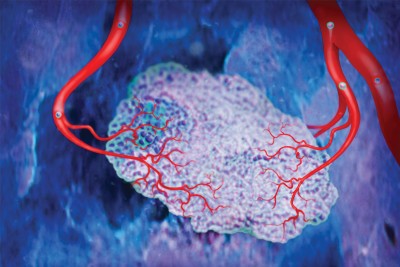
Rendering of a primary tumor mass with adjoining blood vessels (shown in red). Cells that have detached from the tumor and entered the bloodstream (shown as spheres) may circle back to the tumor and enhance its growth and aggressiveness.
It has long been known that circulating tumor cells (CTCs) — cells that have broken away from a patient’s primary tumor and entered the bloodstream — can travel to distant organs and seed new tumors. But a recent Memorial Sloan Kettering study now shows that such spread of disease, known as metastasis, operates in the opposite direction as well: Some CTCs can circle back and infiltrate their tumor of origin, enhancing its growth and aggressiveness.
The newly described phenomenon, called self-seeding, might explain why, in some patients, tumors that are removed by surgery or radiation reappear in the same spot later in life.
The researchers created experimental models of different human cancers — including breast, colon, and skin cancer — that allowed them to track the journey of CTCs throughout a mouse’s body. Their studies showed that primary tumors emit molecular signals that attract some CTCs back to their source. The investigators identified two genes, IL-6 and IL-8, which produce the signals attracting the most aggressive segment of the CTC population, plus three other genes that the returning CTCs use to invade the tumor when they return.
The researchers hope that opportunities to target these genes therapeutically will present new strategies to stop cancer from progressing. Their findings, published in the December 24 issue of Cell, are also prompting new questions about cancer and its treatment.
“For instance, what happens in the scarred and inflamed tissue that is left behind after a tumor has been removed?” asked Joan Massagué, Chair of the Sloan Kettering Institute’s Cancer Biology and Genetics Program, who led the study together with research fellow Mi-Yong Kim and Larry Norton, Deputy Physician-in-Chief for Memorial Sloan Kettering’s Breast Cancer Programs. “Can circulating tumor cells be drawn to that tissue, seed in it, and reproduce the tumor?” He and his colleagues have started to explore these possibilities and the implications they may have for therapy.
